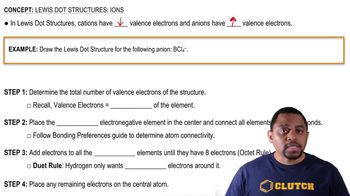Draw the Lewis structure for each of the following:
a. H3COCH3 (the atoms are in the order C O C)
 Verified step by step guidance
Verified step by step guidance Verified video answer for a similar problem:
Verified video answer for a similar problem:



 0:37m
0:37mMaster Lewis Dot Structures: Neutral Compounds (Simplified) Concept 1 with a bite sized video explanation from Jules
Start learning